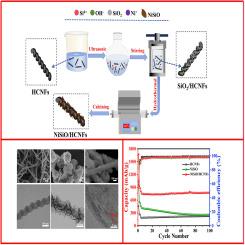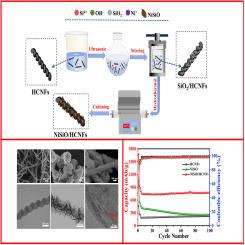螺旋碳纳米纤维增强硅酸镍:高性能锂离子电池的创新负极材料
IF 5.6
3区 材料科学
Q1 ELECTROCHEMISTRY
引用次数: 0
摘要
金属硅酸盐具有优异的储能性能、天然丰度和生态友好性,被认为是锂离子电池负极材料的理想选择。然而,锂离子插入/提取过程中的电子传递效率和结构膨胀/收缩严重阻碍了它们的实际应用。本研究通过水热法成功合成了层状硅酸镍/螺旋碳纳米纤维(NiSiO/HCNFs)纳米复合材料,并将其用作锂离子电池的负极材料。复合材料表现出优异的电化学性能。在200 mA/g电流密度下,其初始放电比容量为1671.04 mAh/g, 100次循环后保持774.87 mAh/g,分别是HCNFs (225.89 mAh/g)和NiSiO (259.06 mAh/g)的3.4倍和2.9倍。这些增强主要归因于hcnf和NiSiO之间的协同相互作用。具体来说,HCNFs独特的三维螺旋结构提供了机械稳定性,有效地减轻了NiSiO在充放电过程中的体积变化。同时,HCNFs提高了电导率,增强了Li⁺的扩散动力学,降低了电荷转移阻抗。这项研究证明了HCNFs作为结构和导电支撑的潜力,为高性能阳极材料的设计提供了有价值的见解。本文章由计算机程序翻译,如有差异,请以英文原文为准。


Helical carbon nanofibers-enhanced nickel silicate: An innovative anode material for high-performance lithium-ion batteries
Metal silicates are considered promising candidates for anode materials in lithium-ion batteries (LIBs) due to their excellent energy storage capability, natural abundance and eco-friendly characteristics. However, their practical application has is significantly impeded by weak electron transport efficiency and structural expansion/contraction during lithium-ion insertion/extraction. In this research, a layered nickel silicate/helical carbon nanofiber (NiSiO/HCNFs) nanocomposite is successfully synthesized through a straightforward hydrothermal approach and employed as anode material for LIBs. The composite exhibits superior electrochemical performance. At a current density of 200 mA/g, it achieves an initial discharge specific capacity of 1671.04 mAh/g and maintains 774.87 mAh/g after 100 cycles, which are approximately 3.4 and 2.9 times higher than those of HCNFs (225.89 mAh/g) and NiSiO (259.06 mAh/g), respectively. These enhancements are primarily attributed to the synergistic interaction between HCNFs and NiSiO. Specifically, the unique three-dimensional helical structure of HCNFs provides mechanical stability, effectively mitigating the volume changes of NiSiO during charge/discharge processes. Meanwhile, the HCNFs improve electrical conductivity, enhance Li⁺ diffusion kinetics, and reduce charge-transfer impedance. This study demonstrates the potential of HCNFs as a structural and conductive support, offering valuable insights for the design of high-performance anode materials.
求助全文
通过发布文献求助,成功后即可免费获取论文全文。
去求助
来源期刊

Electrochimica Acta
工程技术-电化学
CiteScore
11.30
自引率
6.10%
发文量
1634
审稿时长
41 days
期刊介绍:
Electrochimica Acta is an international journal. It is intended for the publication of both original work and reviews in the field of electrochemistry. Electrochemistry should be interpreted to mean any of the research fields covered by the Divisions of the International Society of Electrochemistry listed below, as well as emerging scientific domains covered by ISE New Topics Committee.
 求助内容:
求助内容: 应助结果提醒方式:
应助结果提醒方式:


